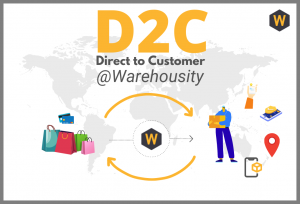From Inventory to Fulfillment: How a D2C Ecommerce Agency Streamlines Operations
Wiki Article
The Future of Retail: Just How D2C Ecommerce Provider Can Transform Your Business
The retail landscape is evolving, driven by the surge of direct-to-consumer (D2C) ecommerce services. Brands are increasingly looking for ways to link with customers on an individual degree while simplifying their operations. This shift not only boosts profit margins but likewise modifies the buying experience significantly. As companies adjust to these modifications, the ramifications for brand loyalty and client involvement end up being crucial. What techniques will specify success in this new era?Recognizing the D2C Ecommerce Model
As consumers significantly look for customized purchasing experiences, the Direct-to-Consumer (D2C) ecommerce version has actually emerged as a transformative strategy in retail. This version enables brand names to market straight to their customers, bypassing conventional middlemans like merchants and dealers. By establishing a straight partnership with customers, firms can acquire deeper insights into customer preferences and behaviors.D2C ecommerce leverages electronic platforms, allowing brands to control their distribution, prices, and advertising and marketing processes. This method fosters agility, permitting organizations to adapt rapidly to market patterns and customer comments. Notably, D2C versions usually use data analytics to enhance item offerings and customer interaction strategies.In a progressively competitive landscape, the D2C design encourages companies to cultivate brand loyalty and produce customized experiences that resonate with their target audience. By doing this, recognizing the ins and outs of D2C ecommerce is vital for brand names intending to thrive in the modern-day retail environment.Advantages of Direct-to-Consumer Strategies
While many companies grapple with the complexities of standard retail, the Direct-to-Consumer (D2C) technique supplies unique advantages that can considerably boost brand efficiency. By eliminating intermediaries, brands keep better control over their pricing, product discussion, and overall client experience. This direct partnership cultivates brand name commitment, as customers feel more attached to the brand and its values.Additionally, D2C methods usually lead to higher profit margins, because companies can keep the entire retail cost as opposed to sharing it with representatives or stores. D2C designs also permit brand names to react quickly to market fads and consumer choices, promoting more active supply monitoring and item development. Businesses can produce customized marketing projects that resonate with their target market, ultimately driving higher conversion rates. In this advancing retail landscape, D2C strategies provide an opportunity for brand names to separate themselves and accomplish sustainable development.Leveraging Information Analytics for Customer Insights

Recognizing Customer Behavior Patterns
Just how can organizations efficiently decode the intricacies of consumer habits in a quickly advancing digital landscape? By using data analytics, business can get valuable insights into their customers' routines, preferences, and motivations. Analyzing searching patterns, purchase background, and comments permits brands to determine patterns and section their audience properly. This understanding not only enhances item offerings but additionally customizes advertising strategies, promoting more powerful customer partnerships. In addition, companies can keep track of social networks interactions and on the internet testimonials to determine view and adjust to transforming customer expectations. This way, data-driven strategies encourage brands to anticipate requirements and fine-tune their techniques, inevitably resulting in raised consumer fulfillment and commitment in the affordable D2C ecommerce setting.Anticipating Analytics for Fads
As businesses endeavor to stay affordable in the D2C ecommerce landscape, leveraging anticipating analytics ends up being essential for identifying arising patterns and customer preferences. By assessing historical data, companies can anticipate future buying behaviors, allowing them to tailor their offerings properly. Anticipating analytics allows retailers to section their target market based on buying patterns, ensuring targeted advertising and marketing approaches that resonate with distinctive customer teams. In addition, these understandings help with stock management, lowering overstock and minimizing stockouts. As new patterns arise, companies can quickly adapt their product, boosting customer satisfaction and commitment. Eventually, the integration of anticipating analytics encourages D2C brand names to make data-driven choices, promoting development and development in an increasingly vibrant market.Enhancing Consumer Involvement Via Customization
While numerous brand names acknowledge the value of customer involvement, personalization arises as a vital technique to cultivate deeper links with consumers (D2C Ecommerce Agency). By leveraging data analytics, brands can tailor experiences to individual preferences, producing a more pertinent buying journey. Individualized suggestions, targeted promos, and customized web content greatly enhance the customer experience, making consumers feel valued and understood.Moreover, utilizing different communication networks enables brand names to involve customers in ways that resonate with them. As an example, personalized e-mails, social media communications, and customized internet site experiences can drive loyalty and repeat acquisitions. This strategy not just boosts customer satisfaction yet additionally urges brand name advocacy, as completely satisfied customers are extra likely to share their favorable experiences with others.Ultimately, customization is not simply a fad yet an essential element of successful D2C ecommerce approaches, allowing brands to develop long lasting relationships and boost their market click here visibilityImproving Supply Chain and Procedures

Structure Brand Name Loyalty in an Open Market

Individualized Purchasing Experience
The contemporary customer landscape is characterized by a frustrating option of brand names and items, making it vital for businesses to differentiate themselves through personalized buying experiences. By leveraging data analytics and customer understandings, brands can tailor their offerings to specific choices, consequently improving customer satisfaction. Individualized recommendations, targeted promos, and personalized interaction can cultivate a sense of connection, making consumers really feel valued. This method not only improves immediate sales but additionally cultivates lasting brand loyalty. In addition, D2C ecommerce services enable brand names to gather real-time comments and adapt their approaches appropriately, making sure importance in a vibrant market. Eventually, a customized purchasing experience can change laid-back purchasers right into devoted advocates, strengthening a brand name's setting in an affordable landscape.Involving Brand Name Narration
Compelling brand name narration serves as a powerful device for services venturing to construct commitment in an open market. By weaving stories that reverberate with consumers, brands can develop emotional connections that prolong beyond transactions. Involving tales highlight a brand name's worths, objective, and one-of-a-kind marketing propositions, allowing customers to recognize with the brand on an individual level. D2C Ecommerce Agency. This link promotes trust and urges repeat purchases, as consumers feel straightened with a brand's principles. Additionally, effective storytelling can set apart a brand from its competitors, making it much more memorable in a crowded marketplace. As consumers significantly seek credibility and significance in their options, brand names that spend in engaging narration are likely to grow long-term connections and improve client loyaltyFuture Trends in D2C Ecommerce Solutions
As customer choices progress, D2C ecommerce solutions are poised to undertake significant makeovers in the coming years. Boosted customization will become a crucial trend, with brands leveraging AI and information analytics to tailor buying experiences to private customers. Additionally, sustainability will become a prime focus, as customers significantly seek eco-friendly items and clear supply chains, triggering brand names to embrace greener practices.Omnichannel techniques will likewise get grip, incorporating on-line platforms with physical touchpoints to develop seamless client journeys. Mobile business will remain to increase, driven by innovations in technology and changing purchasing behaviors, making it vital for brands to enhance their mobile user interfaces. Social business is set to climb, with platforms promoting straight acquisitions via social media, improving brand communication. Eventually, these fads represent a shift toward more dexterous, consumer-centric techniques in D2C ecommerce, making it possible for brands to remain affordable in a quickly altering landscape.Frequently Asked Inquiries
What Preliminary Investments Are Needed for Starting a D2C Ecommerce Business?
Starting a D2C ecommerce organization needs initial investments in site development, supply, digital advertising, and logistics. Additionally, funds for branding, client service, and settlement handling systems are necessary to develop a successful on the internet presence.
Just How Can Local Business Contend With Established D2C Brands?
Small companies can take on well established D2C brand names by concentrating on niche markets, leveraging individualized consumer experiences, using social media sites for involvement, and executing active approaches that adjust to customer comments and industry trends.What Are Common Challenges Faced by D2C Ecommerce Startups?
Common obstacles encountered by D2C ecommerce startups include limited brand recognition, high consumer purchase costs, supply chain management concerns, competition from developed players, and the demand for efficient electronic advertising methods to drive traffic and conversions. - D2C Ecommerce AgencyJust how Do Returns and Reimbursements Operate in D2C Ecommerce?
In D2C ecommerce, returns and reimbursements typically include consumers initiating the process via the site. Policies differ by business, but a lot of offer clear instructions, timeframes, and conditions for returning things, guaranteeing customer fulfillment and loyalty.Are There Lawful Factors To Consider for D2C Ecommerce Businesses?
Lawful factors to consider for D2C ecommerce companies consist of conformity with consumer protection laws, data privacy policies, and copyright civil liberties. Business need to additionally address taxation and shipping laws to assure authorized operations in their corresponding markets. Importantly, D2C models frequently use data analytics to enhance item offerings and customer engagement strategies.In a significantly affordable landscape, the D2C design empowers companies to grow brand loyalty and develop tailored experiences that reverberate with their target audience. While many businesses grapple with the intricacies of standard retail, the Direct-to-Consumer (D2C) method uses distinctive advantages that can greatly boost brand name performance. D2C versions likewise allow brands to respond swiftly to market trends and consumer choices, promoting even more active stock management and item development. Additionally, D2C ecommerce solutions make it possible for brand names to collect real-time responses and adapt their approaches as necessary, ensuring significance in a vibrant market. Involving tales highlight a brand's values, goal, and distinct marketing proposals, allowing consumers to recognize with the brand on a personal level.Report this wiki page